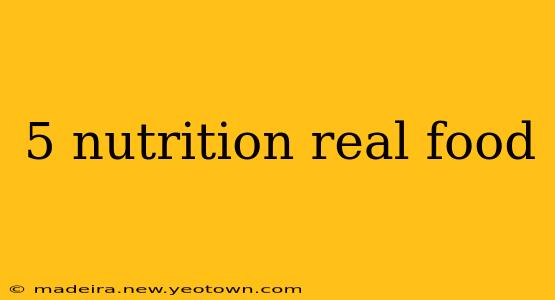5 Nutrition Powerhouses: Real Foods That Fuel Your Body
Let's be honest, the world of nutrition can feel overwhelming. Endless diet fads, conflicting information, and confusing labels leave many of us feeling lost in the supermarket aisles. But the truth is, nourishing your body doesn't have to be complicated. Focusing on real foods – whole, unprocessed ingredients – is the key to unlocking vibrant health and sustained energy. This isn't about restrictive diets; it's about embracing the power of nature's pantry. Let's explore five nutritional superstars that deserve a prominent place on your plate.
1. Leafy Greens: The Unsung Heroes
Imagine a food so packed with vitamins, minerals, and antioxidants that it practically glows. That's the magic of leafy greens! From spinach and kale to collard greens and romaine lettuce, these humble vegetables are nutritional dynamos. They're brimming with Vitamin K, Vitamin A, Vitamin C, folate, and potassium, all crucial for bone health, immune function, and overall wellbeing.
Why are leafy greens so important? They're low in calories but high in fiber, keeping you feeling full and satisfied while promoting healthy digestion. Their abundant antioxidants help protect your cells from damage, reducing the risk of chronic diseases.
How to incorporate them: Add them to smoothies, salads, stir-fries, or even enjoy them as a side dish, lightly steamed or sautéed.
2. Berries: Nature's Candy
Sweet, juicy, and bursting with flavor, berries aren't just a delicious treat; they're a powerhouse of nutrients. Strawberries, blueberries, raspberries, and blackberries are all rich in antioxidants, particularly anthocyanins, which give them their vibrant colors and potent health benefits.
What are the benefits of berries? They're excellent sources of Vitamin C, fiber, and manganese, contributing to a healthy immune system, improved digestion, and even enhanced brain function. Studies suggest that regular consumption of berries may help reduce the risk of heart disease and certain types of cancer.
How to enjoy them: Eat them fresh as a snack, add them to yogurt or oatmeal, or incorporate them into baked goods for a healthy twist.
3. Salmon: The Omega-3 Champion
This fatty fish is a true nutritional superstar, renowned for its high concentration of Omega-3 fatty acids, essential fats that our bodies can't produce on their own. These healthy fats are vital for brain health, heart health, and reducing inflammation throughout the body. Salmon is also an excellent source of protein and Vitamin D.
Why is Salmon so beneficial? Omega-3s have been linked to a reduced risk of heart disease, stroke, and depression. They also play a crucial role in maintaining healthy brain function and reducing inflammation, which is at the root of many chronic illnesses.
How to prepare it: Bake, grill, pan-fry, or even enjoy it as sushi.
4. Avocados: The Creamy, Healthy Fat
Often misunderstood as a high-fat food, avocados are a nutritional goldmine. Their healthy fats are primarily monounsaturated fats, which are beneficial for heart health. Avocados are also a great source of fiber, potassium, and Vitamin K.
Why are avocados so good for you? The healthy fats in avocados help regulate cholesterol levels, promote satiety, and support nutrient absorption from other foods. Their high fiber content aids digestion and helps maintain healthy blood sugar levels. The potassium content contributes to healthy blood pressure.
How to eat them: Enjoy them in guacamole, salads, on toast, or sliced as a side dish.
5. Nuts & Seeds: Tiny Powerhouses
These tiny nutritional powerhouses are packed with healthy fats, fiber, protein, and a wide range of vitamins and minerals. Almonds, walnuts, chia seeds, flax seeds, and pumpkin seeds are just a few examples of the incredible variety available.
What are the benefits of nuts and seeds? They're excellent sources of healthy fats, fiber, and protein, keeping you feeling full and energized. They're also rich in antioxidants and essential minerals like magnesium and selenium, vital for various bodily functions.
How to consume them: Enjoy them as a snack, add them to yogurt or oatmeal, sprinkle them on salads, or use them in baking.
Frequently Asked Questions
What are some easy ways to incorporate more real foods into my diet? Start by gradually replacing processed foods with whole foods. Add a side salad to your lunch, swap sugary snacks for fruit, and choose whole grains over refined grains. Small changes can make a big difference!
Are there any specific real foods that are particularly good for weight loss? While no single food guarantees weight loss, focusing on nutrient-dense foods like those listed above, combined with regular exercise and a balanced calorie intake, can significantly contribute to a healthy weight. Leafy greens and berries, in particular, are low in calories and high in fiber, promoting fullness and aiding in weight management.
Can I get all the nutrients I need from real foods alone? Generally, yes. A diverse diet rich in whole, unprocessed foods provides most of the essential nutrients your body needs. However, some individuals may benefit from supplementation, particularly if they have specific dietary restrictions or underlying health conditions. Always consult with a healthcare professional or registered dietitian for personalized advice.
Remember, the journey to better health is a marathon, not a sprint. By incorporating these five nutritional powerhouses into your diet and focusing on real, whole foods, you'll be well on your way to a healthier, happier, and more energized you.

